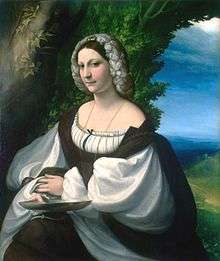Veronica Gambara
Veronica Gambara (November 29 or 30, 1485[1][2] – June 13, 1550) was an Italian poet, stateswoman and political leader. She was the ruler of the County of Corregio from 1518 until 1550.

Biography
Born in Pralboino (now in the Province of Brescia), in Lombardy, Italy, Gambara came from a distinguished family, one of the seven children of Count Gianfrancesco da Gambara and Alda Pio da Carpi.[1] Her family contained a number of distinguished female intellectuals, including her great-aunts, the humanist poets Ginevre and Isotta Nogarola.[3]:164 Veronica was also a niece of Emilia Pia, the principal female interlocutor of Baldessare Castiglione's Il Cortegiano.[4]:160–61
Gambara received a humanist education, studying Latin, Greek, philosophy, theology and scripture.[4]:160[3]:170 In 1502, at the age of 17, she began corresponding with the leading neo-Petrarchan, Pietro Bembo, who became her poetic mentor two years later when she began sending him her compositions.[4]:161[3]:170
In 1509, at the age of 24, she married her cousin, the 50-year-old widower Giberto X, Count of Correggio, in Amalfi.[1] They had two sons, Ippolito was born in 1510 and Girolamo in 1511.[1] After Giberto's death in 1518, she took charge of the state (including management of Correggio's condottieri), as well as the education of her two sons and step-daughter Costanza.[5]:23[3]:171
Under Gambara's rule, the small court of Correggio became something of a salon, visited by such important figures as Pietro Bembo, Gian Giorgio Trissino, Marcantonio Flaminio, Ludovico Ariosto, and Titian.[3]:170[5]:25 Previously aligned with French king, Francis I, Gambara allied Correggio with Holy Roman Emperor Charles V.[1] She personally received Charles V at her estate in 1530, when he signed a treaty guaranteeing Correggio would not again be besieged, and a second time in 1533.[1] The treaty was broken, however, in 1538 when Galeotto Pico II, Count of Mirandola and Concordia, launched an attack on Correggio.[5]:24 Gambara organized a successful defense of the city, and between 1546 and 1550, saw that Charles V paid for improved fortifications.[5]:24[1]
Poetry and correspondence
Approximately 80 of her poems and 150 of her letters are extant, and a complete English translation of her poems was published in 2014.[6] Little of her poetry was published during her lifetime, though it circulated in manuscript and was well-known throughout Italy by 1530.[3]:169 Gambara primarily composed poetry in Italian falling into four categories: poems on political issues, devotional poems, Virgilian pastoral, and love poems to her husband.[3]:170–71 Her political poems are particularly notable for expressing a concept of Italy as an entity centuries prior to unification.[5]:24 Most of her poems are sonnets, although she also wrote madrigals, ballads, and stanze in ottava rima. She also composed a number of poems in Latin, including an ode for Charles V with which she greeted the fellow sovereign on his visit to Correggio in 1530.[3]:170–71
Gambara was in correspondence with a number of important scholars and poets of the day. Beyond the above-mentioned Pietro Bembo, she corresponded with the poet Bernardo Tasso, the writer Matteo Bandello, and author and playwright Pietro Aretino (who would come to slander her as a "laureated harlot," an attack Gambara simply ignored).[5]:24[3]:171 She also exchanged letters with Charles V.[1] Gambara's letters, never intended for publication, shed light on her personal life. In a 1549 letter to Ludovico Rosso she admits to exhaustion with her responsibilities, and expresses a desire to retire to a solitary country life.[1][5]:25
Notes
- Moody, Ellen (April 19, 2004). "Under the Sign of Dido: Veronica Gambara (1485–1550), Life, Letters, and Poetry". Retrieved June 11, 2018.
- Wilson, Katharina M.; Schlueter, Paul; Schlueter, June (2013-12-16). Women Writers of Great Britain and Europe: An Encyclopedia. Routledge. p. 163. ISBN 978-1-135-61670-0.
- Stevenson, Jane (2005). Women Latin Poets: Language, Gender, and Authority, from Antiquity to the Eighteenth Century. New York: Oxford University Press.
- Robin, Larsen and Levin (2007). Encyclopedia of Women in the Renaissance: Italy, France and England. Santa Barbara: ABC-CLIO.
- Stortoni, Laura (1997). Women Poets of the Italian Renaissance: Courtly Ladies and Courtesans. New York: Italica Press.
- Martin, Molly; Ugolini, Paola (June 2014). Veronica Gambara, Complete Poems. A Bilingual Edition. The University of Toronto.
References
- Robin, Diana Maury, Larsen, Anne R. and Levin, Carole (2007). Encyclopedia of women in the Renaissance: Italy, France, and England. ABC-CLIO, Inc. pp. 160–61.CS1 maint: uses authors parameter (link)
- Under the Sign of Dido: Veronica Gambara (1485–1550), Life, Letters, and Poetry Ellen Moody April 2004. Accessed July 20012.
- Stevenson, Jane (2005). Women Latin Poets: Language, Gender, and Authority from Antiquity to the Eighteenth Century. New York: Oxford University Press. pp. 156–171. ISBN 0198185022.
- Stortoni, Laura A (1997). Women Poets of the Italian Renaissance: Courtly Ladies and Courtesans. New York: Italica Press. pp. 23–5. ISBN 0934977437.
- Martin, Molly; Ugolini, Paola (June 2014). Veronica Gambara, Complete Poems. A Bilingual Edition. The University of Toronto.